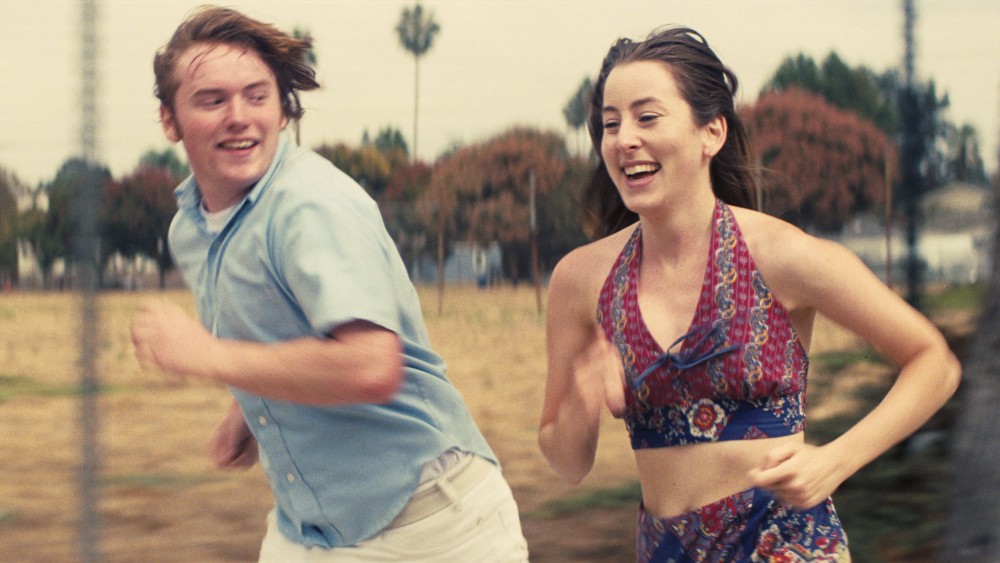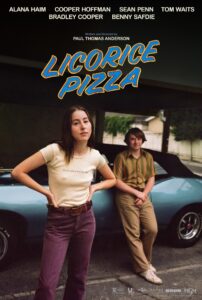
To say that Paul Thomas Anderson’s Licorice Pizza is an enigma or an anomaly might be an understatement. After all, those two words in the film’s title are never uttered or explained even once. (It’s actually a beloved record store of Anderson’s that once resided in the L.A. Valley.) There’s also the fact that Anderson cast Alana Haim, the youngest sister in the rock group Haim, as his female lead, and Cooper Hoffman, son of Anderson’s frequent collaborator, the late Philip Seymour Hoffman, as the male lead. Neither of them has acted in a movie before.
Haim’s character, also named Alana, and Hoffman’s character, Gary Valentine, meet at the latter’s high school where the significantly senior woman is working. She’s 25, he’s 15, and she’s shocked by the gusto and confidence the teenager has about asking her out to dinner. It’s also the early ‘70s in Encino, when that sort of thing probably wouldn’t be deemed statutory rape. Gary is a child actor, whose confidence comes from all the work he’s done at such a young age, but Alana is skeptical and a little stand-offish, even as she’s charmed by the boy’s gumption.
Over the course of the next two and a half hours, the story of Licorice Pizza’s main character unfolds in an episodic manner. One moment, Gary and Alana are selling waterbeds, the hot and popular new trend, the next they’re trying to escape from a crazed customer as the waterbed craze (sorry) dries up.
Unlike some of Anderson’s most recent films, Licorice Pizza is far more of a love story that unfolds in a fairly straightforward manner than Punch Drunk Love, but also builds on the nostalgia factor of Boogie Nights, and the “L.A.-ness” of Magnolia. It’s a bit of a mishmash of ideas and tones, but Anderson’s ability to find young, untapped talented as he’s done in some of his earlier films continues. The confidence he puts into his two discoveries that lead the film really pays off, although Haim is able to instill her character with far more dimension and layers than Hoffman’s Gary Valentine. As with most women, Alana is a mystery, an enigma, a fiery young woman who is exploding with rage one minute and then mooning over one of Gary’s young actor friends the next. You never know how she’ll react, although one frequently feels bad that Gary’s overt feelings towards her are frequently being rejected, even as they both try to make the other jealous.
For whatever reason, Anderson decided to cast Haim’s entire family, including both her sisters, mother and father, around her, but it’s even more curious why she would constantly be hanging with the teen Gary and his even younger business partners. There are many more flagrant “What the?” moments, though, i.e. what is John Michael Higgins doing speaking in offense broken English to his female Japanese business partners? These are moments that almost detract from the story Anderson is trying to tell, and it only serves to remind one how un-PC and problematic the ‘70s actually were, for those who weren’t there or have forgotten.

It isn’t exactly clear which year during the ‘70s the film takes place until more towards the end when the film’s 1973 setting becomes more apparent from the introduction of L.A.’s mayoral race and the gas crisis that hit the country. (And then a giant movie marquee for the Bond movie, Live and Let Die, for those who want more clarity.) Incidentally, Anderson was only three years old in ‘73, but the story behind the film goes that he was inspired by stories told to him by former child actor and later producer, Gary Goetzman, whose early acting stint in movies like Yours, Mine, and Ours, starring Lucille Ball, Anderson rigorously cops from to make people believe these are his own personal stories. (Incidentally, Goetzman is currently an exec. at Tom Hanks’ Playtone production company, but none of the three are involved with Anderson’s film. Goetzman does get a thanks in the credits.)
As far as the crafts, Licorice Pizza’s true champion is Music Supervisor Linda Cohen. Whether it’s nostalgia or some sort of ‘70s fetish, Anderson leans WAY too hard on his soundtrack, and why not? There was a lot of great music in the ‘70s, but it’s also something that will inevitably lead to comparisons to Boogie Nights and coming-of-age films by other filmmakers. In fact, the musical choices (or needle drops, if you prefer) are so good at times that they overshadow Jonny Greenwood’s score, which is given far more room to shine in Pablo Larrain’s Spencer and Jane Campion’s The Power of the Dog.
As with Phantom Thread, Anderson acts as his own Cinematographer, along with first-timer Michael Bauman, who has worked in the lighting department on previous Anderson films. The results are satisfactory but unimpressive compared to Anderson’s previous work with Mihai Malaimare Jr. (The Master) and Robert Elswit (There Will Be Blood).
Similarly, the production design and costumes by Florencia Martin (another creative getting a promotion from an earlier Anderson film) and two-time Oscar winner Mark Bridges (Phantom Thread), respectively, do a fine job recreating the era of the Valley which Anderson was trying to achieve. And yet, there’s nothing that really stands out in the same way as these same crafts did in Quentin Tarantino’s Once Upon a Time… in Hollywood, a few years back. Same with the hair and make-up, these departments all doing a fine job recreating an era where laid-back and almost slovenly looks at times were the norm.
It takes almost an hour for Anderson’s latest to really pick up, and when it does, boy, does it pick up! Maybe it’s when Sean Penn and Tom Waits enter the picture as two Hollywood players, the former setting his eye on the far younger Alana. They are then almost immediately one-upped and over-shadowed by Bradley Cooper as a caricature of famed Hollywood producer, Jon Peters. That interaction leads to the movie’s biggest and best “Sister Christian” moment, where there’s so much tension around what might happen to the duo and their friends.
In some ways, Licorice Pizza’s focus on young lovers makes it feel more like a movie that might have been made by Richard Linklater or even Rushmore-era Wes Anderson. That might be somewhat of a backhanded compliment, since that makes it feel slightly inferior to what PTA should be capable of this long into his career and after unforgettable epics, such as There Will be Blood or The Master. In that sense, Licorice Pizza is perpetually entertaining and ultimately quite enjoyable, but only time will tell if it’s particularly memorable.
Rating: 7.5/10
Photos courtesy MGM Pictures.





